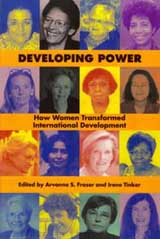-
This volume covers twenty seven individuals' efforts in the 1970s and 1980s to operationalise the 'women in development' (WID) idea internationally. All the contributors are from the first generation of female civil servants, country representatives, academics and activists who pushed women's development interests through their careers in senior positions. Starting out in the 1950s and 1960s, most acknowledge not being feminists to be begin with, but many do recall having a strong sense of their own worth and independence. This they tend to attribute to their mothers; however their class backgrounds look also to be also a clear factor. Often it was personal experiences of various affronts to their early sense of self-worth and independence that helped, later, to foster these women's feminist commitments.
-
For example, prior to a thirty year career with the United Nations (UN), Kristen Timothy spent time as a student volunteer to Malawi. There she recalls seeing 'women carrying heavy burdens on their heads and babies on their backs, hoeing for long hours in the fields, and selling food in the local markets' (p. 51), but also that at the time she had little curiosity about this. Only later, in the anti-Vietnam war movement did she begin to experience and identify 'male chauvinism,' and to then recognise its workings in development assistance. In colonial Kenya, Eddah Gachukia grew her feminist consciousness through 'protests against discrimination that targeted Africans in general' which brought her into discussions with other women over national political leadership after independence. Back in the US, Arvonne Fraser became an 'eager convert' to the feminist movement after her husband was elected to Congress in 1962 and she 'discovered that wives were supposed to gladly give up their careers?and follow their husbands to Washington' (p. 165). Eventually, in the mid-1970s she joined the UN Commission on the Status of Women as a US delegate, going on to head the Office of Women in Development in the US Agency for International Development (USAID).
-
But in actually promoting a WID agenda, Ester Boserup's Women's Role in Economic Development (1970) is widely acknowledged as an enduring influence and an important debating weapon. For example, Jane Jaquette talks of often 'sparring with a male expert' over WID in USAID in the 1970s. In that bureaucratic context, she found Boserup's liberal economics background to be particularly useful. Interestingly, Cornelia Butler Flora argues that senior men in the philanthropic Ford Foundation in the US were more generally sympathetic to WID than many of their counterparts in field offices in Latin America. She attributes this to feminist networks having access to the 'interlocking directorates among male leaders of international development agencies' (p. 284). By contrast, male field staff were less likely to encounter WID advocates and they tended to characterise feminism is a form of 'cultural imperialism.'
-
It is useful to be reminded of the significance of the four UN World Women's Conferences, begun in 1975 in Mexico City and concluded in Beijing in 1995. A good many of the contributors to this book did not simply attend, they organised these conferences and the NGO forums that came to be linked to them. One of these planners and organisers was Leticia Ramos Shahani. Born in the Philippines, and educated at Wellesley College in the US, she joined the Secretariat of the UN in 1964 and then the Section on the Status of Women in 1967. Upon returning to the Philippines she was her own country's representative to the UN Commission on the Status of Women, which lead her to play a major role in the initial drafting of the 1980 Convention on the Elimination of All Forms of Discrimination Against Women (CEDAW) in 1980.
-
As intimated above, the twenty seven stories tend to focus on careers, but there are also references to private lives: long and short marriages, divorce and widowhood and, of course, children (in various numbers). I especially enjoyed Irene Tinker's story of driving in a Ford Anglia (with friends) from London to New Delhi via the Middle East and back in a new Austin via Africa (with a new husband) in the early 1950s. It read like another world and, in very many respects, it was. Times have changed and the debates over women, gender and masculinities have moved on; however, Developing Power is a timely reminder of the activism that was required to first put WID on the international agenda.

|

